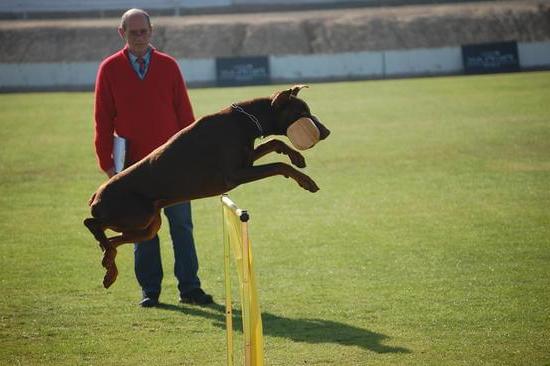Training a dog can be a rewarding and fulfilling experience, but it can also come with its challenges. If you find yourself struggling with a disobedient dog, you are not alone. Many pet owners face similar frustrations when their furry companions refuse to listen or follow commands. However, understanding the behavior of disobedient dogs is crucial in order to effectively train them.
In this article, we will explore various factors that contribute to disobedience in dogs and provide valuable insights on how to address these issues. We will delve into the root causes of disobedience and discuss how to establish a relationship of trust and authority with your dog. Additionally, we will outline effective training techniques that specifically cater to the needs of disobedient dogs.
One key aspect we will emphasize throughout this article is the power of positive reinforcement. By using rewards and incentives instead of punishment, you can motivate your dog to learn and obey commands willingly. Furthermore, we will address common problem behaviors such as jumping, excessive barking, and leash pulling, offering practical tips on how to tackle them effectively.
By nurturing obedience through consistency and routine, you can set clear expectations for your dog and help them understand what is expected of them. We will also provide guidance on dealing with more challenging cases involving stubbornness in dogs.
Whether you have just adopted a new pet or have been struggling with an unruly companion for years, this article aims to equip you with the knowledge and tools necessary to train your disobedient dog successfully. Remember that building a strong bond with your furry friend is essential for achieving long-lasting obedience. So let’s embark on this training journey together and celebrate the progress made along the way.
Assessing the Root Causes of Disobedience in Dogs
When faced with a disobedient dog, it is crucial to assess and understand the root causes of their behavior. While every dog is unique, disobedience can stem from various factors including lack of training, fear or anxiety, boredom, inadequate socialization, or even underlying health issues. By identifying the underlying cause, you can tailor your training approach and address the specific needs of your furry companion.
Lack of Training
One common cause of disobedience in dogs is simply a lack of proper training. Dogs thrive on structure and routines, and without clear guidelines and boundaries from their owners, they may become confused or exhibit unwanted behaviors.
In such cases, it is important to establish a foundation of basic obedience training that includes commands like sit, stay, come, and heel. Consistency is key when teaching these commands; reinforcing them with positive rewards will help your dog understand what behavior is expected from them.
Fear or Anxiety
Another possible cause for disobedience can be fear or anxiety in dogs. Some dogs may react to certain situations by exhibiting aggressive behaviors or refusing to follow commands due to feeling threatened or overwhelmed. It is crucial to observe your dog’s body language and identify triggers that may elicit this response. By gradually exposing your dog to these triggers using desensitization techniques while providing reassurance and positive reinforcement, you can help reduce their fear and build their confidence.
Boredom and Lack of Stimulation
Dogs are naturally curious animals that require mental stimulation and physical exercise to prevent boredom. When left alone for long periods without any form of entertainment or outlet for their energy, they may resort to destructive behaviors or even refuse to obey commands out of frustration. Providing your dog with interactive toys, regular exercise sessions, and engaging activities such as puzzle-solving or scent tracking can keep their minds stimulated and help alleviate their disobedient tendencies.
By assessing the root causes of your dog’s disobedience, you can gain insights into their behavior and implement targeted training techniques to address these issues. Whether it’s providing basic obedience training, addressing fear or anxiety, or combating boredom, a comprehensive approach that incorporates positive reinforcement and consistency will set the foundation for a well-behaved and happy canine companion.
Establishing a Relationship of Trust and Authority with Your Dog
Establishing a strong relationship based on trust and authority is crucial when training a disobedient dog. Without these key elements, it will be challenging to effectively communicate with your dog and teach them proper behavior. In this section, we will discuss the importance of building trust and authority with your dog as well as some strategies to achieve this.
Understanding the Importance of Trust
Trust forms the foundation of any successful relationship, including the one you have with your dog. Building trust involves creating an environment where your dog feels safe, secure, and loved. It means establishing a bond that makes your furry friend confident in your guidance and willing to follow your commands. When your dog trusts you, they are more likely to obey you willingly rather than out of fear or coercion.
To build trust with your disobedient dog, consistency is key. Be consistent in your words, actions, and expectations towards your pet. Set clear boundaries and stick to them so that your dog understands what is expected of them. Additionally, prioritize positive interactions with your dog such as playtime, gentle petting, or rewards for good behavior. This positive reinforcement helps strengthen the bond between you and encourages trust.
Establishing Authority
Establishing authority does not mean resorting to dominance or aggression; instead, it requires being a calm and assertive leader for your dog. Dogs are instinctually pack animals and naturally seek a leader figure to provide guidance and direction. By establishing yourself as the leader in a loving yet firm manner, you can gain control over their behavior.
Consistency plays a vital role in establishing authority as well. Dogs thrive on routine and clear expectations from their owners. Set rules for behavior consistently and enforce them without exceptions. Use confident body language, firm but gentle vocal commands, and leash communication to convey that you are in control.
It is also important to note that punishment should never be used as a means of establishing authority. Instead, focusing on positive reinforcement and rewarding good behavior is more effective and humane. When your dog understands that good behavior leads to pleasurable outcomes such as treats or praise, they will be more motivated to obey your commands willingly.
Effective Training Techniques for Disobedient Dogs
When it comes to training a disobedient dog, it’s important to approach the process with patience, consistency, and the right techniques. In this section, we will explore some effective training techniques that can help you address and correct disobedient behaviors in your furry companion.
One of the most crucial aspects of training a disobedient dog is using positive reinforcement. Positive reinforcement involves rewarding your dog for exhibiting desired behaviors, such as sitting or staying when commanded. This can be accomplished by offering treats, praise, or playtime as a reward. By consistently reinforcing good behavior and ignoring unwanted behavior, your dog will quickly learn to associate obedience with positive outcomes.
Another effective technique for training disobedient dogs is clicker training. Clicker training utilizes a small device that makes a distinctive clicking sound when pressed. The sound is then paired with a reward to reinforce good behavior.
For example, if you are teaching your dog to sit, you would press the clicker when they sit down and then immediately give them a treat or verbal praise. Over time, your dog will come to understand that the clicker sound signifies that they have done something right.
Additionally, leash training can be an essential part of addressing disobedience. If your dog pulls on the leash during walks or exhibits other undesirable behaviors while on a leash, it’s important to use proper techniques to correct these issues. One effective method is called “stop-and-go” training. This involves stopping every time your dog starts pulling on the leash and only moving forward once they stop pulling and return to their designated heel position beside you.
By implementing these effective training techniques along with patience and consistency, you can successfully address disobedience in your furry friend and build a strong bond based on trust and obedience.
| Training Technique | Description |
|---|---|
| Positive Reinforcement | Rewarding desired behaviors with treats, praise, or playtime. |
| Clicker Training | Using a clicker sound paired with rewards to reinforce good behavior. |
| Leash Training – Stop-and-Go Method | Stopping every time the dog pulls on the leash and only moving forward when they return to a designated heel position. |
The Power of Positive Reinforcement in Dog Training
Positive reinforcement is a powerful tool when it comes to training disobedient dogs. This technique involves rewarding your dog for performing desired behaviors, which helps to reinforce those behaviors and increase the likelihood of them occurring again in the future. By focusing on positive reinforcement rather than punishment, you can create a more positive and enjoyable training experience for both you and your dog.
One of the key benefits of using positive reinforcement is that it strengthens the bond between you and your dog. When your dog understands that good behavior will be rewarded with treats, praise, or playtime, they become eager to please and eager to learn. This creates a positive cycle where your dog actively seeks out opportunities to behave well and receive their rewards.
When implementing positive reinforcement, it’s important to choose rewards that are highly motivating for your dog. Different dogs have different preferences, so experiment with treats, toys, or even verbal praise to find what works best for your furry friend. The reward should be something that your dog finds valuable enough to work for but not so enticing that they become overly distracted or hyperactive.
Consistency is crucial when using positive reinforcement. Be sure to reward your dog immediately after they perform the desired behavior so they understand exactly what they’re being rewarded for. Additionally, make sure everyone in your household is on board with using positive reinforcement consistently so as not to confuse or undermine the training process.
By employing positive reinforcement techniques in your training sessions, you’ll find that teaching obedience becomes much easier and more enjoyable for both you and your four-legged companion. With patience and consistency, you’ll be able to shape desirable behaviors in even the most disobedient of dogs while building a stronger bond based on trust and cooperation.
Addressing Specific Disobedient Behaviors
Many dog owners struggle with specific disobedient behaviors such as jumping, barking, and pulling on the leash. These behaviors can be frustrating and even dangerous if not properly addressed. Luckily, there are effective techniques to tackle each of these issues and foster better behavior in your furry friend.
- Jumping: Dogs often jump on people out of excitement or as a way to get attention. To address this behavior, consistency is key. Start by turning away from your dog and crossing your arms whenever they jump.
Avoid eye contact or any form of acknowledgment until they have all four paws back on the ground. Once they’re calm, reward them with praise or treats. With practice, your dog will learn that jumping does not lead to attention but staying calm does. - Barking: Barking is a natural form of communication for dogs but excessive barking can be problematic. To manage this behavior, it is important to understand why your dog is barking in the first place. Is it due to boredom, fear, excitement, or territoriality?
Once you identify the trigger for their barking, you can work towards addressing it directly. For instance, if your dog barks out of boredom, ensure they have plenty of mental stimulation through interactive toys or puzzle games. - Pulling on the leash: Walking a dog that constantly pulls on the leash can be exhausting for both you and your pet. To curb this behavior, start by teaching them a solid “heel” command using positive reinforcement techniques like treats or praise whenever they walk at your side without pulling. Additionally, consider using a front-clip harness that discourages pulling by redirecting their momentum when they try to tug ahead.
By consistently working on these specific disobedient behaviors using positive reinforcement and effective techniques tailored to each issue, you’ll be able to address them successfully and improve your dog’s overall obedience. Remember that patience and consistency are key, and with time, your dog will understand what is expected of them.
Nurturing Obedience Through Consistency and Routine
One of the most important aspects of training a disobedient dog is establishing a routine and being consistent in your approach. Dogs thrive on structure and consistency, and when they know what to expect from their owners, they are more likely to behave obediently. Consistency means that you should set clear expectations for your dog’s behavior and enforce those rules consistently. This means not allowing your dog to get away with certain behaviors sometimes, but not others.
Establishing a routine is also crucial for nurturing obedience in your dog. Dogs are creatures of habit, so setting up a consistent daily schedule can help them understand what is expected of them. This includes regular feeding times, exercise routines, and designated potty breaks. By sticking to a routine, you can create a sense of stability and security for your dog, which can help reduce any anxiety or stress that may contribute to disobedience.
Here are some key tips for nurturing obedience through consistency and routine:
- Set clear rules: Make sure everyone in your household knows the rules for your dog’s behavior and enforces them consistently. Dogs can become confused if different family members have different expectations.
- Use positive reinforcement: Reward your dog when they exhibit good behavior that aligns with the rules you’ve established. This could be giving them treats or verbal praise. Positive reinforcement helps reinforce obedience by associating good behavior with rewards.
- Stick to a daily schedule: Create a daily routine for feeding, exercise, training sessions, playtime, and rest time. Try to stick to this schedule as closely as possible to create familiarity and predictability for your dog.
By establishing consistency and routine in training your disobedient dog, you can create an environment that fosters obedience. Remember that patience is key during this process – it may take time for your dog to adapt to the new routines and habits you’re establishing. With perseverance and dedication, you’ll be able to nurture obedience in your furry friend and build a stronger bond together.
| Tips for Nurturing Obedience Through Consistency and Routine |
|---|
| 1. Set clear rules |
| 2. Use positive reinforcement |
| 3. Stick to a daily schedule |
Dealing with Difficult Cases
Training a disobedient dog can be challenging, but dealing with stubbornness takes it to another level. If your dog tends to dig their paws in and resist your efforts, it’s important not to get discouraged. By understanding the root causes of stubborn behavior and implementing effective training techniques, you can overcome stubbornness in your dog and build a stronger bond.
One common cause of stubborn behavior in dogs is a lack of motivation. Some dogs simply don’t see the benefit or reward of obeying commands. This can stem from inconsistent training or unclear expectations from their owners. To overcome this, it’s crucial to establish clear boundaries and set realistic goals for your dog’s training. Make sure you use positive reinforcement techniques such as treats or praise when they show signs of progress or obey commands successfully.
Another factor that contributes to stubborn behavior is fear or anxiety. Dogs may act stubbornly if they associate certain situations or commands with negative experiences or discomfort. It’s important to approach their training with patience and empathy, using gentle encouragement rather than punishment. Slowly expose your dog to these triggers while gradually building up their confidence and trust in you as their owner.
In addition, consistency plays a vital role in overcoming stubbornness in dogs. Consistent routines help dogs understand what is expected of them and what behaviors are acceptable. Establishing consistent rules, routines, and training sessions will help your dog understand the boundaries that are set for them. Remember that consistency goes hand in hand with patience – it may take time for your dog to truly grasp the new behaviors you are teaching them.
By understanding the underlying causes of stubbornness in dogs and implementing consistent training methods that focus on positive reinforcement, you can make significant progress in overcoming this challenging behavior. It’s important to remember that each dog is unique, so what works for one may not work for another.
Be patient, stay consistent, and celebrate even the smallest victories along the way. Overcoming stubbornness requires time and effort, but the rewards are immeasurable – a stronger bond with your well-trained and obedient dog.
Additional Tips and Tricks for Training Your Disobedient Dog
Training a disobedient dog can be challenging, but with dedication and the right techniques, it is possible to transform their behavior. In addition to the effective training techniques mentioned in the previous section, there are some additional tips and tricks that can help you in your journey to train your disobedient dog.
- Set Realistic Goals: It’s important to have realistic expectations when training a disobedient dog. Rome wasn’t built in a day, and similarly, your dog’s behavior won’t change overnight. Set small goals and celebrate each milestone along the way. This will help keep you motivated and reinforce positive behaviors.
- Use Different Rewards: While positive reinforcement is a powerful tool, it’s essential to find what motivates your dog the most. Experiment with different rewards such as treats, toys, or praise to find out what works best for your furry friend. Remember that not all dogs are food-motivated, so finding the right reward can make a significant difference in their response to training.
- Be Consistent: Consistency is key when it comes to training any dog, especially a disobedient one. Establish clear rules from the beginning and ensure that everyone in the household follows them consistently. Inconsistency can confuse your dog and hinder progress in their training.
- Seek Professional Help: If you find yourself struggling with training your disobedient dog despite your best efforts, don’t hesitate to seek professional help. A certified dog trainer or behaviorist has expertise in dealing with various behavioral issues and can provide personalized guidance tailored to your specific situation.
Remember that every dog is unique, so what works for one may not work for another. Be patient with your furry companion as they learn new behaviors and continue building trust between you both. With time, effort, and these additional tips and tricks, you’ll be well on your way to transforming your disobedient dog into a well-behaved and obedient canine companion.
Conclusion
In conclusion, training a disobedient dog requires patience, understanding, and consistent effort. By following the steps outlined in this article, you can create a strong foundation of trust and authority with your furry friend. Remember that building a lifelong bond with your dog is not just about correcting their disobedient behaviors, but also about celebrating the progress they make.
As you implement effective training techniques and utilize positive reinforcement, you will see noticeable improvements in your dog’s behavior. Whether it is jumping, barking, pulling on the leash, or any other specific issue, addressing these behaviors consistently and with routine will lead to positive results.
Dealing with difficult cases and stubbornness may require extra time and effort. However, by staying committed to your training methods and seeking professional guidance if needed, you can overcome these challenges. It is important to remember that every dog is unique and requires personalized attention in their training process.
Finally, as you continue to train your disobedient dog, always remember to celebrate their progress along the way. Recognize even small victories and offer praise and rewards when deserved. This positive reinforcement will not only motivate your dog but also strengthen the bond between you both.
In the end, by investing time and effort into training your disobedient dog, you are not only shaping their behavior but also building a lifelong bond based on trust and respect. With patience and consistency, you can transform your furry companion into a well-behaved dog who brings joy and happiness to your life every day.
Frequently Asked Questions
How do you discipline a dog that doesn’t listen?
Disciplining a dog that doesn’t listen can be challenging, but it’s important to approach it in a positive and consistent manner. One effective method is through positive reinforcement training. This involves rewarding your dog for good behavior with treats, praise, or playtime, while ignoring or redirecting unwanted behavior.
Consistency is crucial; you should establish clear rules and commands that are consistently reinforced by everyone in the household. Additionally, consider using verbal cues paired with hand signals to enhance communication with your dog. It’s crucial to avoid harsh punishments or physical discipline as this may cause fear or aggression in your dog.
How do you fix a disobedient dog?
Fixing a disobedient dog requires patience, consistency, and understanding of their individual needs. Start by identifying any potential underlying issues contributing to their disobedience – it could be lack of proper training, socialization, exercise, mental stimulation, or health issues. Address these needs accordingly.
A structured routine with regular training sessions can help establish boundaries and reinforce desired behavior. Use positive reinforcement techniques like rewarding good behavior and teaching new commands gradually. If necessary, consult professional trainers who specialize in behavioral modification for additional guidance tailored to your specific situation.
What is the most disobedient dog breed?
While no breed is inherently more disobedient than others, certain breeds may possess traits that make them more independent-minded or prone to challenging authority if not properly trained and socialized from an early age. Breeds such as Siberian Huskies, Afghan Hounds, Chow Chows, or Basenjis are often considered more independent and less inclined to blindly obey commands compared to some other breeds that have been bred specifically for biddability such as Retriever or Border Collie breeds.
However, it is essential to remember that breed characteristics do not solely determine obedience levels; individual temperament and training influence a dog’s behavior significantly regardless of their breed. Furthermore, every dog is unique and has the potential to learn obedience skills with consistent training and appropriate handling techniques.

Welcome to the blog! I am a professional dog trainer and have been working with dogs for many years. In this blog, I will be discussing various topics related to dog training, including tips, tricks, and advice. I hope you find this information helpful and informative. Thanks for reading!





